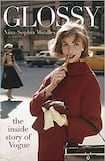
“Vogue magazine started, like so many great things do, in the spare room of someone’s house.” Thus begins this epic history of a publication that today, 150 years later, can claim more than 427 million digital consumers, 88 million in print, and online video content that generates in excess of one billion monthly views.
Author Nina Sophia Miralles, founder of a London-focused cultural magazine, has provided an exhaustive and very entertaining history of a legendary organisation from its inception in New York in 1892 as a society rag to its present existence as a multinational corporation and uncontested market leader. It is full of stories.
There have been many books by and about Vogue over the years, prominent among them Jane Mulvagh’s masterly Vogue: History of 20th Century Fashion, as well as various memoirs and biographies, but this is the first comprehensive history of the magazine itself. It is divided into 17 well-written and researched chapters, some of which are so extensive they could make the bones of an individual book. Miralles has an eye for the telling detail.
Readers are taken on a journey through three centuries and two World Wars, describing the magazine’s publishers and editors from the fearsome Edna Woolman Chase to her modern incarnation in Anna Wintour. The interplay between creativity and commerce and the way different editors forged their own agendas is skilfully outlined.
More importantly, Glossy shows how Vogue survived many rocky periods, how a luxury magazine represented the changing role of women through the decades, how editors responded to the world around them, and the magazine’s relevance or otherwise in today’s turbulent times.
Condé Nast, which took over Vogue in 1909, kickstarted its creation as a profitable female-centred, class-based luxury magazine under the editorship of the formidable Woolman Chase. The New Yorker promoted young writers such as the Irish Carmel Snow and engineered the very first US fashion show in 1914.
British Vogue, nicknamed Brogue, was established under the openly homosexual and forceful Dorothy Todd, a visionary editor who insisted that “Vogue has no intention of confining its pages to hats and frocks”. She was later followed by Alison Settle, who was particularly interested in animal welfare.
The section describing the travails of Vogue Paris are amusing, such as trying to prise the flamboyant fashion illustrator Christian Berard out of brothels, bistros or theatre rehearsals to meet deadlines. Foreign work practices drove the Americans crazy. French editors wouldn’t return from lunch until at least 4 and only truly got stuck into the magazine around 5. Models, including one who landed in Paris in a parachute, were a problem too, creating an atmosphere of suspicion, rivalry and lethargy “and the air smelled like a gym since deodorant had not yet been popularized.”
Watching British Vogue coping with the second World War and air raids while maintaining that wearing white was “in” during blackouts gave one observer the appearance as “unnervingly like children playing war”.
One of the few left-leaning Vogue editors, Audrey Withers, disapproved of Dior “because it was impossible to wear [his clothes] on a bus”. Brendan Bracken identified the importance of women’s magazines, asserting that “the nation was women since the men were out fighting”.
The magazine’s golden years followed. Miralles argues that “no period oozes glamour like the mid-century covers under the guidance of Alexander Liberman, who used art as a commercial prop and connected the hallowed ground of fine art to fashion”.
Peppered with amusing anecdotes, the story of how Si Newhouse came to take over Vogue from Nast is the stuff of legend. One morning his fashion-conscious wife, Mitzi, urged him not to forget to buy Vogue for her. He, misunderstanding her request, went out and bought the entire company for $5 million, when all she wanted was the latest issue. The Newhouse family still own the company.
Editors who stuck to their principles often paid the price. In Paris, Edmonde Charles-Roux saw fashion as an agent for change and wanted to put a black model on the cover in 1966; she was refused by Newhouse, an act of racism, and fired. Later that same model, Donyale Luna, became the first ever black model to have a cover on British Vogue.
The 1960s “arrived like a stroke of lightning” along with miniskirts, rock’n’roll and space travel. So did the age of budgets at Vogue, to which Diana Vreeland, then editor of the US edition, paid absolutely no heed. She once sent David Bailey all the way to India to photograph white tigers and never ran the images. Another shoot that took five weeks in Japan in 1966 cost $7.5 million in today’s money and was the most expensive fashion shoot in history. Vreeland, writes Miralles, “was the autocratic editor from hell long before Anna Wintour”.
Wintour, of course, is the subject of several chapters. Miralles is sharp in her analysis of Wintour’s career, work practices, and unpleasant demeanour: “Her icy attitude was inherited from her father known as Chilly Charles, his glacial exterior only the tip of the iceberg.” She is unsparing in her criticism or fulsome in her praise for other editors, dissecting everyone from Joan Juliet Buck and Caroline Roitfeld in Paris to Alexandra Shulman and Edward Enninful in London.
What next for Vogue, grappling with a fast-moving online world? Miralles concludes that it “has survived wars that have toppled nations, suffered losses that could bankrupt entire states and sustained a brand legacy…. No one can truly believe there will be an end. Vogue will always be Vogue.”









